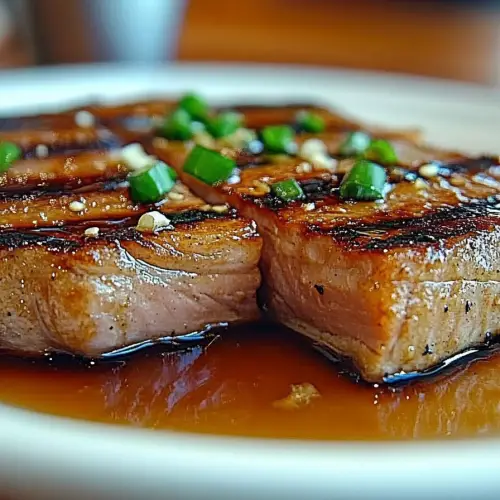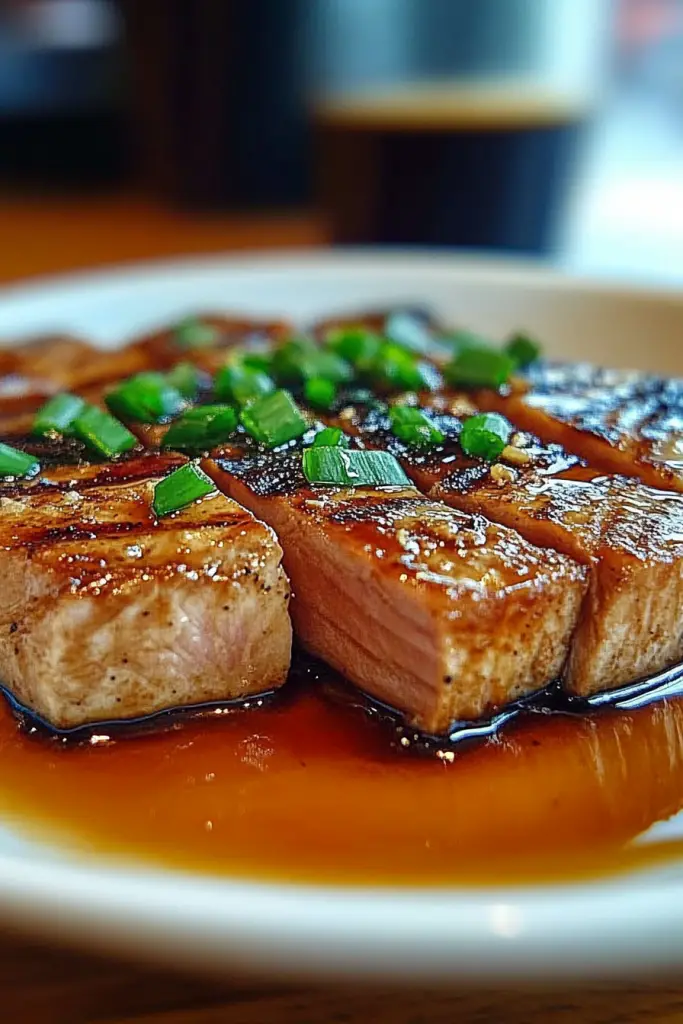There are some meals that just stick with you, aren’t there? The ones you crave on a lazy Sunday afternoon, or the ones that save you when you’ve completely forgotten to plan dinner and suddenly have people arriving in an hour. For me, that meal is this Soy ginger tuna steak. It’s not just a recipe; it’s my culinary superpower. Honestly, when I first stumbled upon a similar idea years ago, I was a little skeptical. Tuna steak? Could it really be *that* exciting? Oh, boy, was I wrong. This isn’t your average pan-seared tuna; it’s an explosion of savory, sweet, and tangy flavors that dance on your tongue. It’s like a little vacation for your taste buds. If you’ve ever enjoyed a really good teriyaki chicken or a flavorful stir-fry, imagine that concentrated into a perfectly cooked, melt-in-your-mouth tuna steak. That’s what we’re talking about here, and I’m so thrilled to finally share this one with you.
Thank you for reading this post, don't forget to subscribe!What is soy ginger tuna stew?
So, what exactly *is* this magical soy ginger tuna steak? At its heart, it’s incredibly simple. We’re talking about beautiful, fresh tuna steaks that get a quick, flavorful marinade and then a swift sear. The “soy ginger” part comes from that irresistible marinade – a harmonious blend of soy sauce (or tamari for a gluten-free twist), fresh ginger, garlic, a touch of sweetness, and maybe a secret ingredient or two that I’ll let you in on. Think of it as a quick, savory spa treatment for your tuna before it hits the hot pan. It’s not a heavy, cooked-down sauce like you might find in some Asian dishes; instead, the marinade infuses the tuna with incredible depth of flavor without overpowering its delicate, meaty texture. It’s essentially taking high-quality seafood and giving it a flavor boost that makes it sing. It’s elegant enough for guests but so straightforward, you’ll be making it for yourself on weeknights too. It’s that versatile!
Why you’ll love this recipe?
Where do I even begin with why this soy ginger tuna steak is a staple in my kitchen? First and foremost, the flavor is absolutely out of this world. You get that deep, umami richness from the soy sauce, a bright, zesty punch from the fresh ginger, and a subtle warmth from the garlic. Then there’s that hint of sweetness that perfectly balances everything out, making each bite incredibly satisfying. It’s complex without being complicated. And speaking of complicated, let’s talk about how ridiculously easy this is to make. Seriously, from start to finish, you’re looking at maybe 15-20 minutes, max. It’s a lifesaver on those nights when you’re exhausted but still want something delicious and healthy. Plus, tuna steaks are surprisingly budget-friendly if you buy them frozen and thaw them yourself. It’s a win-win-win! I also love how versatile it is. You can serve it over a bed of fluffy rice, alongside a vibrant stir-fry, or even just with a simple side salad. It fits into so many meal plans and dietary preferences (especially if you opt for tamari). What truly sets this apart for me, though, is that it feels so much more special than just throwing a piece of fish in a pan. It’s a little bit of culinary magic that you can whip up in minutes. It’s definitely one of those recipes that makes you feel like a rockstar in the kitchen, even if you’re just cooking for yourself.
How do I make soy ginger tuna stew?
Quick Overview
The process for this soy ginger tuna steak is beautifully straightforward: marinate, sear, and serve. We’ll whisk together a quick, potent marinade, let the tuna steaks soak it all in for just a few minutes, and then give them a super-hot sear to get that gorgeous crust while keeping the inside wonderfully tender and almost rare. It’s all about speed and high heat to lock in those incredible flavors and textures. The beauty of this method is that it’s forgiving; you’re unlikely to overcook it if you follow the searing times, and the marinade does most of the heavy lifting in the flavor department. It’s the kind of recipe that makes you feel like a pro chef with minimal effort.
Ingredients
For the Tuna & Marinade:
1.5 lbs sushi-grade tuna steaks (about 1-inch thick): Look for beautiful, ruby-red steaks. If you can find them at your local fish market or even a good grocery store’s seafood counter, go for it! Sushi-grade means it’s safe to eat raw or lightly seared, which is exactly what we want here. If you can only find regular tuna steaks, that’s okay too, just be sure to cook them a little more thoroughly.
1/2 cup soy sauce (or tamari for gluten-free): This is the salty, savory backbone of our marinade. I prefer a good quality, low-sodium soy sauce so I can control the saltiness better.
2 tablespoons fresh ginger, finely grated: Don’t skimp on fresh ginger! It’s got this incredible warmth and zing that just can’t be replicated. I usually buy a knob of ginger and keep it in the freezer; you can grate it straight from frozen, which is super handy.
2 cloves garlic, minced: For that pungent, aromatic kick. Freshly minced is best here; the bottled stuff just doesn’t have the same punch.
1 tablespoon sesame oil: Adds a lovely nutty depth and aroma. Just a little goes a long way.
“Packed with flavor and so simple. Exactly what I wanted from this Soy ginger tuna!”
1 tablespoon honey or maple syrup: This helps to balance the saltiness of the soy sauce and also aids in caramelization when searing.
1 teaspoon rice vinegar (optional, but recommended): A little splash of acidity brightens everything up and cuts through the richness.
Pinch of red pepper flakes (optional): If you like a little heat, this is your moment!
For Searing:
1-2 tablespoons high-heat oil (like avocado oil or grapeseed oil): We need an oil that can handle the high heat of the pan without smoking too much.
For Serving (Optional but Recommended):
Toasted sesame seeds: For a little crunch and visual appeal.
Thinly sliced green onions: For freshness and a pop of color.
Step-by-Step Instructions
Step 1: Marinate the Tuna
First things first, let’s get our tuna ready for its flavor bath. If your tuna steaks are frozen, make sure they’re fully thawed in the refrigerator. Pat them completely dry with paper towels. This is a crucial step! Moisture is the enemy of a good sear. In a shallow dish or a large zip-top bag, whisk together the soy sauce (or tamari), grated ginger, minced garlic, sesame oil, honey (or maple syrup), rice vinegar (if using), and red pepper flakes (if using). Once everything is combined, lay the tuna steaks in the marinade, making sure they’re coated on all sides. Let them marinate for at least 15 minutes, but no more than 30 minutes. Tuna is delicate, and if you marinate it for too long, the acid in the soy sauce can start to “cook” it, changing the texture. I usually prep the marinade while I’m getting my cooking station ready, and then add the tuna.
Step 2: Prepare for Searing
While the tuna is doing its thing in the marinade, get your searing station ready. This is a fast-cooking dish, so you want everything at your fingertips. If you’re serving it with rice, now’s a good time to get that cooking. Chop your green onions and have your sesame seeds ready to go. Make sure your skillet is clean and ready. A cast-iron skillet or a good quality stainless steel pan works best for achieving a beautiful sear.
Step 3: Heat the Pan
Place your skillet over medium-high to high heat. Let it get nice and hot – this is key for that perfect crust. Once the pan is hot, add your high-heat oil. You want the oil to shimmer, but not smoke excessively. If it starts to smoke like crazy, reduce the heat slightly. A good hot pan is what gives the tuna that delicious caramelized exterior.
“The Soy ginger tuna turned out amazing. My kids asked for seconds. Saving this one!”
Step 4: Sear the Tuna
Carefully remove the tuna steaks from the marinade, letting any excess drip off (but don’t wipe them dry this time!). Place the tuna steaks in the hot skillet. You should hear a satisfying sizzle. Don’t overcrowd the pan; cook in batches if necessary. Sear for about 1.5 to 2 minutes per side for rare, or 2 to 2.5 minutes per side for medium-rare. For tuna, you really want to aim for a beautiful, dark crust on the outside and a vibrant, almost raw interior. If you prefer your tuna more well-done, be aware that it can become dry quickly, so keep a close eye on it. The exact time will depend on the thickness of your steaks and how hot your pan is. I always err on the side of slightly undercooked, as the residual heat will continue to cook it a bit after you remove it from the pan.
Step 5: Rest the Tuna
Once seared to your liking, immediately remove the tuna steaks from the pan and place them on a clean cutting board. Let them rest for at least 5 minutes. This is another important step! Resting allows the juices to redistribute throughout the steak, making it incredibly tender and moist. If you cut into it too soon, all those delicious juices will run out onto the board.
Step 6: Slice and Serve
After resting, slice the tuna steaks against the grain. You’ll see that gorgeous seared exterior contrasting with the beautiful pink or red interior. Arrange the slices on a plate, sprinkle with toasted sesame seeds and sliced green onions, and serve immediately. Drizzle any remaining marinade over the top if you like, or serve it on the side. It’s honestly that simple and that impressive!
What to Serve It With
This soy ginger tuna steak is so versatile, it can truly fit into any mealtime. For a delightful breakfast or a hearty brunch, I love serving it alongside some fluffy scrambled eggs and maybe some avocado slices. The richness of the tuna pairs beautifully with the creamy avocado and the lightness of the eggs. A simple drizzle of sriracha mayo over the top takes it to another level! If you’re thinking of it as a more substantial meal, it’s phenomenal over a bed of steamed jasmine rice. You can even add some blanched broccoli or snap peas to the rice for a complete meal in one bowl. For a lighter lunch or a sophisticated appetizer, you can chop the tuna and toss it with a little more of the marinade, some chopped cucumber, and serve it in lettuce cups or over a bed of mixed greens with a light vinaigrette. And for those times when you’re just craving something utterly delicious and satisfying, serving it with a simple side salad and perhaps some Roasted Sweet potato wedges makes for a perfect cozy dinner. My family especially loves it when I serve it with a side of my quick pickled ginger carrots – the crunch and tang are a fantastic contrast!
Top Tips for Perfecting Your Soy Ginger Tuna Steak
Over the years, I’ve picked up a few tricks that make this recipe foolproof, even if you’re a bit nervous about cooking fish. First, the tuna itself is paramount. Always aim for the freshest, highest quality tuna you can find, preferably sushi-grade. If you’re buying it frozen, make sure it’s thawed completely and *pat it bone dry* with paper towels before it hits the marinade. Any excess moisture will steam the fish instead of searing it. For the marinade, don’t let the tuna sit in it for too long – 15 to 30 minutes is the sweet spot. Any longer and the texture can start to get mushy. I’ve learned this the hard way! When it comes to searing, the heat is your best friend. Make sure your pan is screaming hot before you add the tuna. This creates that beautiful, dark crust and locks in the juices. Don’t be afraid of a little char; that’s where a lot of the flavor comes from! I’ve experimented with different oils, and while Olive oil *can* work in a pinch, high-heat oils like avocado or grapeseed are much better because they won’t burn and turn bitter. For cooking time, trust your instincts but also know that tuna cooks incredibly fast. My rule of thumb for a 1-inch thick steak is about 1.5 to 2 minutes per side for rare, and maybe an extra 30 seconds for medium-rare. It should still be quite pink in the center. Remember that residual heat will continue to cook it, so it’s better to slightly undercook than overcook. And please, please, please let it rest! Just like a good steak, letting the tuna rest for 5 minutes after searing allows the juices to redistribute, ensuring a moist and tender bite. If you skip this, all that goodness will end up on your cutting board. Finally, don’t be afraid to play with the marinade. I sometimes add a tiny bit of mirin for extra sweetness or a splash of lime juice for brightness. It’s your tuna, make it sing for you!
Storing and Reheating Tips
Okay, so what happens if you have some delicious soy ginger tuna left over? The good news is, it stores pretty well, but you need to be mindful of how you do it to keep it tasting its best. For room temperature storage, honestly, I wouldn’t leave cooked tuna out for more than two hours. It’s best to get leftovers into the fridge as soon as they’ve cooled down a bit. In the refrigerator, leftover tuna steak will stay good for about 2 to 3 days. I like to store it in an airtight container. If you want to be extra careful about moisture, you can wrap the individual slices tightly in plastic wrap before placing them in the container. When it comes to freezer instructions, I’m a little more hesitant with cooked tuna because the texture can sometimes suffer a bit upon thawing. However, if you *must* freeze it, wrap the cooled tuna slices very tightly in plastic wrap, then in foil, and place them in a freezer-safe bag or container. It should last for about 1 to 2 months. To reheat, the Absolute Best way is to eat it cold! It’s fantastic in salads or sandwiches the next day. If you absolutely need to reheat it warm, do so very gently. You can briefly pan-sear it again over low heat for just 30 seconds per side, or microwave it for *very* short intervals (10-15 seconds at a time), checking constantly. The goal is to just warm it through without cooking it further. For the glaze, if you made extra, you can store it separately in the fridge for up to a week. I often serve any leftover glaze cold over the reheated tuna or use it as a dressing for a salad. Just remember, the less you reheat it, the better the texture will be!
Frequently Asked Questions
Final Thoughts
So there you have it – my absolute favorite way to prepare tuna steak. It’s the perfect balance of speed, simplicity, and incredible flavor. I truly hope you’ll give this soy ginger tuna steak a try. It’s one of those dishes that feels like a treat but is so accessible, you’ll find yourself making it again and again. Whether you’re looking for a quick weeknight dinner that’s healthy and impressive, or a way to elevate a special occasion, this recipe delivers. It’s a testament to how a few simple, fresh ingredients, combined with a little bit of heat and a lot of flavor, can create something truly memorable. If you love dishes with bold, Asian-inspired flavors, you might also enjoy my recipe for [Link to another relevant recipe, e.g., Honey Garlic Salmon] or my [Link to another relevant recipe, e.g., Quick Shrimp Stir-fry]. I can’t wait to hear how your soy ginger tuna turns out! Please leave a comment below with your thoughts, any variations you tried, or if you have your own favorite tips. Happy cooking!

Soy Ginger Tuna
Ingredients
Main Ingredients
- 2 piece tuna steaks
- 0.25 cup soy sauce
- 2 tablespoon fresh ginger minced
- 1 tablespoon sesame oil
- 0.5 teaspoon garlic powder
- 1 tablespoon honey
- 0.5 cup water
- 2 tablespoon cornstarch
- 1 tablespoon sesame seeds for garnish
- 1 bunch green onions sliced for garnish
Instructions
Preparation Steps
- In a small bowl, whisk together soy sauce, minced ginger, sesame oil, garlic powder, and honey. Set aside.
- Pat the tuna steaks dry with paper towels. Season lightly with salt and pepper.
- Heat a non-stick skillet over medium-high heat. Add the tuna steaks and sear for 1-2 minutes per side, until browned but still rare in the center.
- Remove the tuna from the skillet and set aside.
- In the same skillet, add the prepared soy ginger sauce and water. Bring to a simmer.
- In a small bowl, whisk the cornstarch with 2 tablespoons of water until smooth. Pour the cornstarch slurry into the simmering sauce and whisk until thickened.
- Return the tuna steaks to the skillet and spoon the sauce over them. Cook for another minute until heated through.
- Serve the soy ginger tuna immediately, garnished with sesame seeds and sliced green onions.










